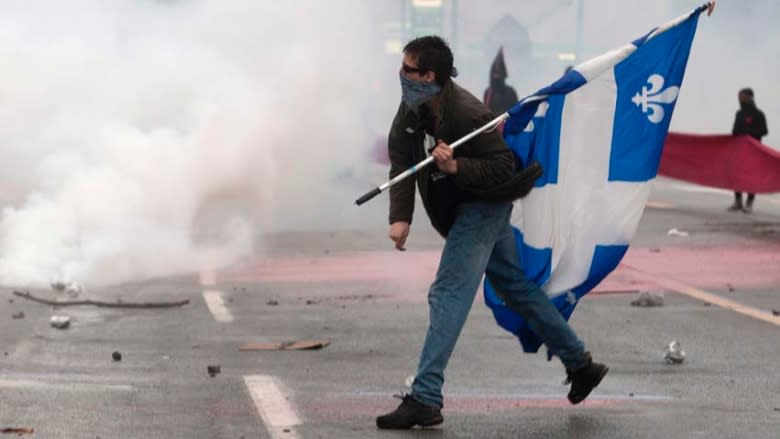Police can't use Highway Safety Code to end protests, Quebec judge rules

A Quebec superior court judge has reaffirmed the right to protest in the streets in a ruling issued on Thursday.
Justice Guy Cournoyer acquitted a protester who was fined under Quebec's Highway Safety Code during an anti-police brutality march in 2011.
Police arrested 239 people during that protest, and about 150 of them were charged under section 500.1 of the code, which prohibits anyone from using a vehicle or other obstacle to block a highway "during a concerted action intended to obstruct in any way vehicular traffic."
The protesters argued that law was adopted to prevent people from blockading roads with vehicles and was never intended to put a stop to demonstrations.
Cournoyer agreed, ruling that applying article 500.1 of the code to break up protests violates both the Quebec and Canadian charters of rights and freedoms.
Right to protest prevails: 'Anarchopanda'
Julien Villeneuve, a professor at Collège de Maisonneuve, told CBC Montreal's Daybreak that the ruling is a victory for the people.
Villeneuve, better known as Anarchopanda from the Quebec 2012 student protests, said it will make a difference for the hundreds who were charged under the code.
"It means another judge agrees with us that in a free and democratic society that it is not up to police to decide who gets to use the roads or protest," said Villeneuve.
The judge has given the Quebec government six months to amend the code.
This could mean the end of political profiling of demonstrators in Quebec and create a safe space for protests, said Villeneuve.
"My concern is to make sure that the space is open for people to protest if they feel it is the most effective way of getting their message out."
Quebec Highway Safety Code 500.1
No person may, during a concerted action intended to obstruct in any way vehicular traffic on a public highway, occupy the roadway, shoulder or any other part of the right of way of or approaches to the highway or place a vehicle or obstacle thereon so as to obstruct vehicular traffic on the highway or access to such a highway.
A peace officer may remove or cause to be removed, at the expense of the owner, any thing used in contravention of this section. The peace officer may also seize such a thing; the provisions respecting things seized in the Code of Penal Procedure (chapter C-25.1) apply, with the necessary modifications, to things so seized.
This section does not apply during parades or other popular events previously authorized by the person responsible for the maintenance of the public highway provided the highway used is closed to traffic or is under the control of a police force.
For the purposes of this section, a public highway includes a road being used as an alternate route for traffic diverted from a public highway even if the alternate route is situated on private property, and a road under the administration of or maintained by the Ministère des Ressources naturelles et de la Faune.


